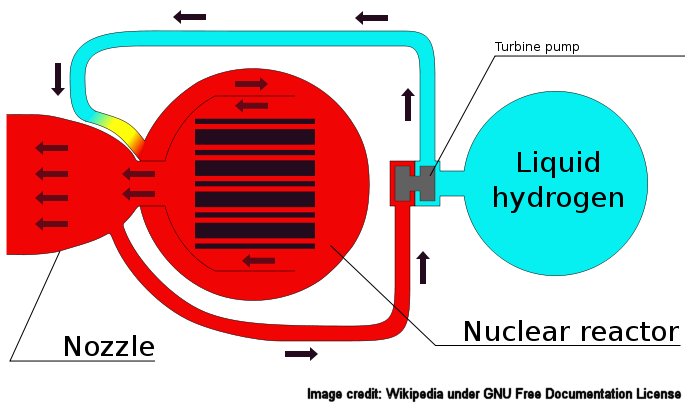Low-Enriched Uranium Nuclear Thermal Propulsion: Propelling Humans to Mars
NASA is developing capabilities of sending people to Mars in the 2030s under the "Journey To Mars" initiative. This plan has public and congressional support but many of the details have not been settled, as of yet. One major issue is that no decision has been made for the type of propulsion vehicle to get humans to Mars.
NASA Administrator Charles Bolden recently testified in the House Space Subcommittee on NASA's fiscal year 2017 budget proposal. Bolden stated he supports nuclear thermal propulsion, and that he and most NASA people believe that "nuclear thermal propulsion will probably be the most effective form of propulsion to get [to Mars]."
Nuclear thermal propulsion (NTP) technology is a well-researched topic that has had cyclic cycles of funding starting from the initial Rover/NERVA program (1955-1972). In the Rover program, 22-fueled nuclear engines were tested, although no flight tests were performed. The program, along with other funded programs, was canceled due to political motivations rather than technical issues.

An NTP engine operates similar to a chemical engine in that hydrogen gas is heated up to high temperatures then expanded through a nozzle to accelerate the engine forward. In a chemical engine, the heat is created from chemical reactions; in an NTP engine, the heat is created using a high power density nuclear reactor. Hydrogen is used to cool the nuclear core, which allows the gas to pick up the heat generated in the core.
When compared to chemical propulsion, NTP allows for faster transit times with longer launch windows to Mars, allows for less cosmic radiation exposure to astronauts, and increases payload capacity so that more supplies can reach Mars.
Historically, reactors created for NTP engines used highly enriched uranium (HEU) because it allowed for compact, high-power density reactors to be created. Unfortunately, since the days of the original NTP engines, HEU has come to bear a large social and political burden due to proliferation risks associated with it. Recent studies, however, have shown that low-enriched uranium (LEU) can be used to create an NTP engine, and Bolden stated that NASA is currently developing a "low-grade nuclear fuel" (low-grade referring to LEU) to enable these efforts.
LEU-NTP is a new type of nuclear propulsion that removes the use of HEU in the nuclear reactor typical in a space system. HEU's absence enables private industry to play a leadership role in NTP development, allows non-nuclear weapons states to pursue NTP, reduces proliferation risks and costs, and conforms to the Department of Energy's HEU reduction mission. All of this is done without sacrificing performance relative to historically tested HEU nuclear engine designs and without throwing away years of research by using many of the same sub-systems created in historical designs.
Research for LEU-NTP reactors is being performed at NASA Marshal Space Flight Center under the Space Capable Cryogenic Thermal Engine Program. Academic institutions and private industry are also pursuing this new technology.
Nuclear thermal propulsion, albeit a proven technology, will require a large multi-year research effort that will span several administrations to be successful. Research for NTP is funded within NASA for $20 million within the FY16 budget and in line to be funded again in FY17. Reactor cores without HEU are being developed, which enables public and private institutions to take part in further research.
With public and private backers, nuclear thermal propulsion will enable NASA's vision to someday put humans on Mars.

